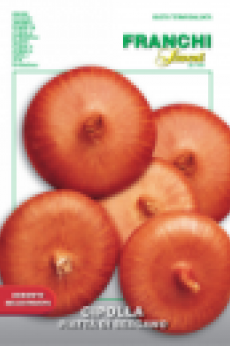
Onion, Cipollo Piatta Di Bergamo
Heirloom Onion Cipollo "Piatta Di Bergamo" Mid-Early 70-75 days Small very flat yellow onion. Onions are tender and juicy with white flesh. They are ideal for eating raw. These are also used as the Italian pickling onion. Medium growth plant. Flat bulb coated with copper-colored protective tunics. Consistent pulp, pinkish-white, tender and tasty. Excellent conservation throughout the winter.
Small, flat, yellow-brown onion for cooking, salads or pickling. Packet contains 1.5 gram (about 350) seed.Grow from transplants or direct seed. For transplants, start in a seed box in late summer/early autumn and transplant to the garden in autumn, spaced 3" apart. Thin direct plantings as they grow and use for salad. Commonly pickled and flavoured with balsamic vinegar.
Originating in Boretto, a small town in the province of Reggio Emilia, whose name they bear, Borettana onions have been cultivated since the 1400’s and for centuries were sold only by local producers. Prized throughout Italy for their unique flavour, they travelled across Europe and to America with Italian immigrants in the 19th century.
The flat onion of Bergamo is an ancient variety of medium-late onion that is characterized by a large bulb, flattened and covered with an intense coppery skin that sometimes tends to purple. The very consistent pulp is white with some pink hues. The sowing of this onion takes place in February while the harvest in August; after which the bulbs are left to dry in the sun in the open field. The harvested onions are stored from August to February in a dry and shady place, such as the attics of the farmhouses.
In the kitchen it is used in various preparations: it can be eaten fresh in salads or cooked. It is used to prepare first courses, omelettes, quiches or pickle.
The flat of Bergamo is most likely mentioned and illustrated in a work by Rodolfo Farneti (professor of plant pathology) of 1892. It is a variety that has always stood out for its excellent shelf life and in the 1940s it was cultivated and he sold in neighboring regions and even in Switzerland. Today it is still marketed but exclusively locally: in fact, over the years it has been replaced by more productive cultivars and few farmers keep their seeds. This variety of onion has been the subject of research by some professors and researchers of the University of Pavia, who have collected in a publication a lot of information on a large number of localLombard varieties ("Traditional Lombard agronomic varieties at risk of extinction or genetic erosion Vegetables and cereals: an overview
